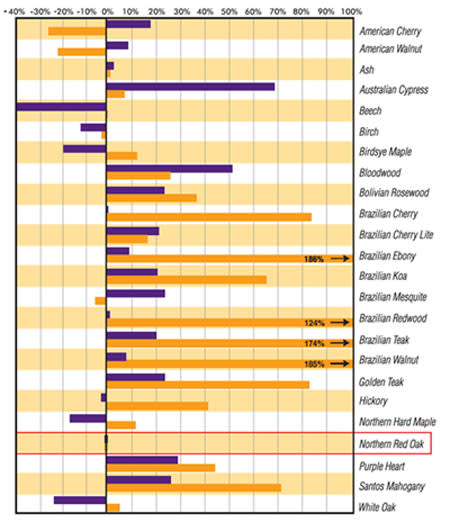- Home
- Education
- Flooring Basics
- Understanding the Janka Scale, Hardness, and Stability
Understanding the Janka Scale, Hardness, and Stability

When you purchase a new wood floor, I’m sure that there are a few things running through your mind. Does it look good? Is it durable? Does LL Flooring's warranty cover scratches? What kind of damage will my 2-year-old and Yorkipoo do to the floor? These are all important things to think about. Durability is a big concern of many customers. Before you choose hardwood based on color, take a look at the hardness and stability of the wood you are interested in.
The hardness of wood reflects its durability and is measured on the Janka hardness scale. The Janka hardness test measures the force required to embed a .444-inch steel ball to half its diameter into the wood. In the picture above, the orange reflects the hardness while the violet reflects stability. Northern Red Oak is the species that all others are compared against and if the Janka rating is higher for that wood, it denotes a harder wood. For example the Janka rating for Northern Red Oak is 1290. Brazilian Walnut, a very hard wood, has a Janka rating of 3680. That makes it roughly 185% harder than Northern Red Oak! It also makes it difficult to install but we’ll leave that for another day. Janka testing helps customers to understand the resistance of wood to wear and denting and is used to approximate product and customer expectations. Even though it creates numerical results for hardness, natural variations are to be expected, even within a species.
Also, there is not a relationship between wood hardness and surface finish wear, which is why manufacturers do not warranty wood flooring against scratching and denting. While it’s true that a particular species used in flooring is durable enough to handle day to day use, that doesn’t mean a harder wood won’t dent.
Trees come from nature and because of their cell structure, all wood products can dent and scratch. So if you take a hammer to your floor and pound as hard as you can, you’ll probably be able to dent your floor. Something we definitely don’t recommend. What did that poor floor do to you anyways?
Appliances and furniture can eventually leave dents on hardwood flooring. Luckily, wood floors can be restored using “Touch-Up Kits”?, individual board replacement, or a total sanding and refinishing of the floor if needed.
No floor is “Scratch Proof”?. However urethane finishes are applied to take limited surface abuse, thereby protecting your investment…the wood underneath. Taking safeguards like applying felt pads to furniture, keeping your floor clean, using rugs or walk-off mats at entrances to the home, keeping your pet’s nails trimmed, not using the “beater-bar”? on your vacuum, or having a “No Shoe”? policy (or at least a “No High Heels”? policy) are good ways to protect your floor.
Another attribute to consider is stability. Stability refers to how much an installed wood floor expands and contracts in relationship to the change in humidity. Northern Red Oak is once again used as a baseline. If the percentage is higher than Northern Red Oak, then is it more stable and reacts less to moisture changes within the environment.
With a little research, you can choose a floor that you will love and will look beautiful for years to come.